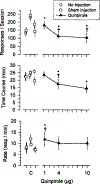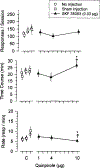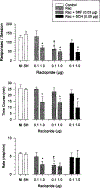Alcohol self-administration: further examination of the role of dopamine receptors in the nucleus accumbens
- PMID: 9309321
- PMCID: PMC11584055
- DOI: 10.1111/j.1530-0277.1997.tb04257.x
Alcohol self-administration: further examination of the role of dopamine receptors in the nucleus accumbens
Abstract
One of the functions of the mesolimbic dopamine (DA) system is to regulate the process of reinforcement, a process that is thought to influence drug self-administration. This study tested the effects of centrally administered DA receptor ligands on ethanol self-administration behavior. Long-Evans rats were trained to lever press on a fixed-ratio 4 schedule of ethanol (10% v/v) reinforcement. DA agonists and antagonists were then bilaterally microinjected (0.5 microliter/side) into the nucleus accumbens (N Acc) 10-min before sessions to test for effects on the onset, maintenance, and termination of ethanol self-administration. Infusions of the D1-like agonist SKF 38393 (0.03 to 3.0 micrograms) produced no effect on ethanol self-administration. The D1-like antagonist SCH 23390 (0.5 to 2.0 micrograms) reduced total responding by decreasing the time course of self-administration without altering response rate. The D2-like agonist quinpirole produced a biphasic effect on self-administration. Quinpirole (1.0 microgram) increased total responses and response rate, whereas higher doses (4.0 to 10.0 micrograms) decreased total responding as a result of early termination. The D2-like antagonist raclopride (0.1 to 1.0 microgram) reduced total responding by decreasing time course and response rate. Co-administration of either SKF 38393 or SCH 23390 with quinpirole prevented the behavioral effects observed with the low doses of quinpirole. Thus, in the N Acc either increased activation of D1-like receptors or their blockade can affect the expression of the behavioral effects of the D2-like agonist. This suggests that some intermediate level of D1 activation is required to observe the D2 effect. The decreases in total responding produced by raclopride were enhanced by co-administration of SKF 38393, but not altered by SCH 23390, thus suggesting that D1-like and D2-like receptors in the N Acc interact in the regulation of ethanol self-administration in a manner similar to their interactive regulation of other behaviors.
Figures





Similar articles
-
Cooperative activation of D1-like and D2-like dopamine receptors in the nucleus accumbens shell is required for the reinstatement of cocaine-seeking behavior in the rat.Neuroscience. 2006 Oct 13;142(2):451-61. doi: 10.1016/j.neuroscience.2006.06.004. Epub 2006 Jul 14. Neuroscience. 2006. PMID: 16844308
-
Dopamine receptors in the medial prefrontal cortex influence ethanol and sucrose-reinforced responding.Alcohol Clin Exp Res. 1996 Dec;20(9):1631-8. doi: 10.1111/j.1530-0277.1996.tb01709.x. Alcohol Clin Exp Res. 1996. PMID: 8986215
-
Dopamine receptor sub-types involvement in nucleus accumbens and ventral tegmentum but not in medial prefrontal cortex: on self-stimulation of lateral hypothalamus and ventral mesencephalon.Behav Brain Res. 1997 Jul;86(2):171-9. doi: 10.1016/s0166-4328(96)02263-2. Behav Brain Res. 1997. PMID: 9134152
-
Role of dopamine D1 and D2 receptors in the nucleus accumbens in mediating reward.J Neurosci. 1997 Nov 1;17(21):8580-7. doi: 10.1523/JNEUROSCI.17-21-08580.1997. J Neurosci. 1997. PMID: 9334429 Free PMC article.
-
Alcohol self-administration: role of mesolimbic dopamine.Ann N Y Acad Sci. 1992 Jun 28;654:242-53. doi: 10.1111/j.1749-6632.1992.tb25971.x. Ann N Y Acad Sci. 1992. PMID: 1352952 Review.
Cited by
-
Involvement of nucleus accumbens dopamine D1 receptors in ethanol drinking, ethanol-induced conditioned place preference, and ethanol-induced psychomotor sensitization in mice.Psychopharmacology (Berl). 2012 Jul;222(1):141-53. doi: 10.1007/s00213-011-2630-8. Epub 2012 Jan 6. Psychopharmacology (Berl). 2012. PMID: 22222864
-
Cooperative activation of dopamine D1 and D2 receptors increases spike firing of nucleus accumbens neurons via G-protein betagamma subunits.J Neurosci. 2003 Jun 15;23(12):5079-87. doi: 10.1523/JNEUROSCI.23-12-05079.2003. J Neurosci. 2003. PMID: 12832531 Free PMC article.
-
Systemic and intra-accumbens microinjections of naltrexone interfere with tolerance to ethanol in rats.Psychopharmacology (Berl). 2005 Nov;182(3):366-74. doi: 10.1007/s00213-005-0095-3. Epub 2005 Oct 19. Psychopharmacology (Berl). 2005. PMID: 16025314
-
Regulation of Pv-specific interneurons in the medial prefrontal cortex and reward-seeking behaviors.J Neurochem. 2021 Jan;156(2):212-224. doi: 10.1111/jnc.15106. Epub 2020 Jul 20. J Neurochem. 2021. PMID: 32594517 Free PMC article.
-
Methylmercury and nutrition: adult effects of fetal exposure in experimental models.Neurotoxicology. 2008 Sep;29(5):783-801. doi: 10.1016/j.neuro.2008.06.007. Epub 2008 Jul 5. Neurotoxicology. 2008. PMID: 18652843 Free PMC article. Review.
References
-
- Colle L, Wise RA: Concurrent facilitory and inhibitory effects of amphetamine on stimulation-induced eating. Brain Res 459:356–360, 1988 - PubMed
-
- Evans KR, Vaccarino FJ: Intra-nucleus accumbens amphetamine: Dose dependent effects on food intake. Pharmacol Biochem Behav 27: 1149–1151, 1986 - PubMed
-
- Dreher JK, Jackson DM: Role of D1 and D2 dopamine receptors in mediating locomotor activity elicited from the nucleus accumbens of rats. Brain Res 487:267–277, 1989 - PubMed
-
- Salamone JD: The involvement of nucleus accumbens dopamine in appetitive and aversive motivation. Behav Brain Res 61:117–133, 1994 - PubMed
-
- Koob GF: Drugs of abuse: Anatomy, pharmacology and function of reward pathways. Trends Pharmacol Sci 13:177–184, 1992 - PubMed
Publication types
MeSH terms
Substances
Grants and funding
LinkOut - more resources
Full Text Sources
Medical
Miscellaneous

